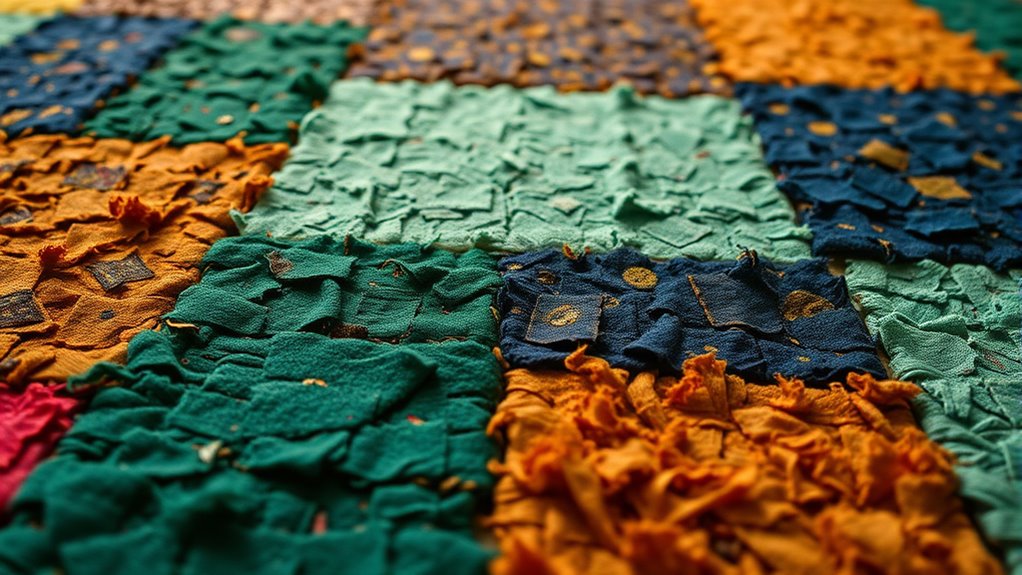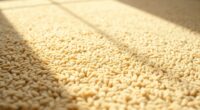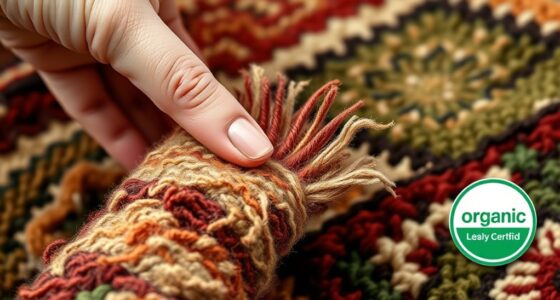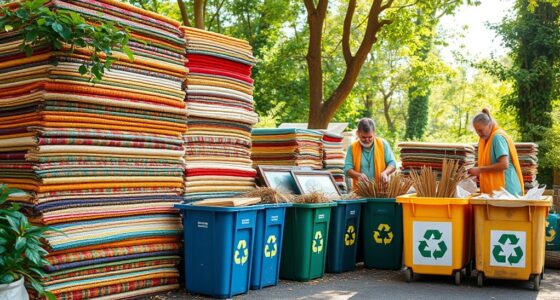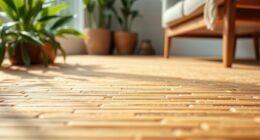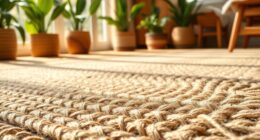Recycled rug materials turn discarded textiles into stunning, eco-friendly flooring options that reduce waste and support sustainability. By upcycling fabrics from old clothing, industrial scraps, or surplus textiles, you can enjoy a luxurious, unique rug that minimizes environmental impact. These rugs often feature natural dyes and local craftsmanship, making them both beautiful and responsible choices. Keep exploring how these innovative materials can elevate your space while benefiting the planet.
Key Takeaways
- Recycled rugs are made from textiles salvaged from old clothing, industrial scraps, and surplus fabrics, promoting waste diversion.
- They utilize eco-friendly dyes derived from natural or plant-based sources for vibrant, chemical-free coloration.
- These rugs feature unique textures and patterns, reflecting their upcycled origins and supporting local craftsmanship.
- Manufactured locally, recycled rugs reduce transportation emissions and support sustainable, community-based production practices.
- They offer a luxurious, eco-conscious flooring option that combines style, sustainability, and waste reduction efforts.
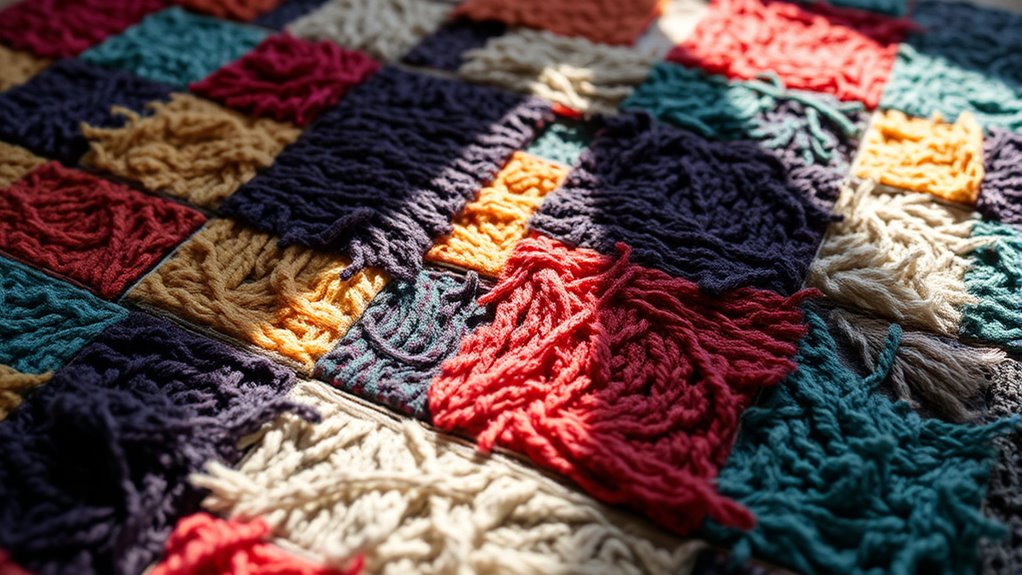
Have you ever considered how rugs made from recycled materials can transform your space while helping the environment? When you choose recycled rugs, you’re making a conscious decision to support sustainable sourcing. Instead of relying on new raw materials, these rugs are crafted from textiles that would otherwise end up in landfills. This not only reduces waste but also minimizes the environmental impact associated with traditional rug manufacturing. By opting for recycled textiles, you’re promoting a circular economy where resources are reused rather than discarded, aligning your decor choices with eco-friendly values.
Sustainable sourcing plays a crucial role in the appeal of recycled rugs. Manufacturers often collect textiles from various sources, such as old clothing, industrial scraps, or surplus fabrics. These materials are then carefully processed to create new, durable rugs without straining natural resources. This approach preserves ecosystems and decreases the demand for virgin materials like wool, cotton, or synthetic fibers, which can be resource-intensive to produce. When you select a rug made from recycled textiles, you’re supporting companies committed to responsible sourcing and reducing environmental degradation.
Another compelling aspect of recycled rugs is the use of eco friendly dyes. Traditional dyes often contain harmful chemicals that can leach into the environment and pose health risks. Eco friendly dyes, on the other hand, are derived from natural or plant-based sources, making them a safer choice for your home and the planet. These dyes are not only better for the environment but also tend to produce vibrant, lasting colors that add character and warmth to your space. The combination of recycled materials and eco friendly dyes results in a visually stunning, sustainable product that doesn’t compromise on style or quality.
When you bring a recycled rug into your home, you’re not just enhancing your decor—you’re making a statement about your values. These rugs often feature unique textures and patterns because they’re crafted from varied textile scraps, giving each piece a one-of-a-kind character. Plus, since many recycled rugs are made locally, you can support small businesses and reduce the carbon footprint associated with transportation. It’s a way to create a luxurious, cozy environment while actively participating in environmental stewardship.
In short, choosing a recycled rug made from sustainably sourced textiles and dyed with eco friendly dyes allows you to decorate consciously. You get a beautiful, high-quality piece that reflects your commitment to reducing waste and protecting the planet. It’s an elegant solution that combines style, sustainability, and social responsibility—all in one luxurious, upcycled package.
Frequently Asked Questions
How Do Recycled Rug Materials Compare in Durability to Traditional Options?
Recycled rug materials often match or even surpass traditional options in durability because their fiber strength can be comparable or higher. Since these textiles are carefully selected and processed, their material longevity remains impressive, providing you with a resilient, long-lasting floor covering. Proper maintenance also helps extend their lifespan, ensuring your investment stays beautiful and durable over time.
Are Recycled Textiles Safe for Homes With Children or Pets?
You might worry about recycled textiles being unsafe for children or pets, but research shows they’re generally safe if properly processed. While some Toxic chemical concerns and allergen risks exist with certain recycled fabrics, reputable manufacturers ensure textiles are thoroughly tested and free from harmful substances. Always choose certified, eco-friendly options, and you’ll have a safe, stylish floor that’s perfect for your family’s needs.
What Are the Maintenance Requirements for Rugs Made From Recycled Materials?
You should follow specific cleaning protocols for recycled textile rugs to maintain their appearance and durability. Regular vacuuming helps prevent dirt buildup, while prompt stain removal preserves stain resistance. Use gentle, eco-friendly cleaning solutions to avoid damaging the fibers. Avoid harsh chemicals, as they can degrade recycled materials over time. By staying consistent with these practices, your rugs will stay beautiful, safe, and long-lasting, even with frequent use.
Can Recycled Rugs Be Customized in Size and Design?
They say, “The sky’s the limit,” and with recycled rugs, that’s true. You can customize their size and design, enjoying great flexibility in your choices. Many suppliers offer customization options, allowing you to select specific dimensions and tailor patterns to match your style. This design flexibility guarantees your recycled rug fits perfectly into your space, giving you a luxurious look while supporting eco-friendly choices.
How Environmentally Friendly Is the Entire Recycling Process for Textiles?
You might wonder how environmentally friendly the recycling process is. It generally has a lower carbon footprint compared to producing new textiles, especially when using chemical recycling methods that break down fibers efficiently. Chemical recycling reduces waste and saves energy, making it a more sustainable choice. While no process is perfect, choosing recycled textiles substantially minimizes environmental impact, helping you contribute to a greener future with luxurious, eco-conscious flooring.
Conclusion
By choosing rugs made from recycled materials, you’re not only elevating your space with luxury but also making a positive environmental impact. Did you know that upcycling textiles can reduce waste by up to 90%? That means every time you opt for recycled rugs, you’re helping to divert massive amounts of textile waste from landfills. So, go ahead—embrace sustainable luxury and make a meaningful difference with your flooring choices.
